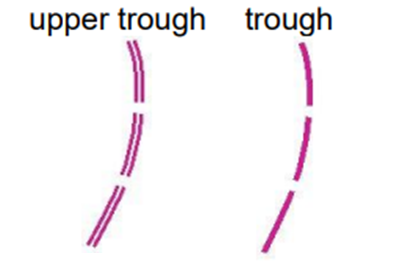







METAR Code
N/A
Weather Symbol

An elongated area of relatively low pressure, extending from a low-pressure region. It is the opposite of a ridge. Troughs mark the locations of converging and rising air that is flowing from higher to lower pressure and are often associated with cloudiness and precipitation. A trough can be at the surface or aloft. If a trough develops at the surface on the leeward (sheltered) side of a mountain range, then it is called a lee trough.
A portion of this definition was taken from the Canada.ca Weather and Meteorology GlossaryOpen a new window
Associated terms coming soon:
Low-pressure system is a term associated with a trough that will be coming soon to the Aviation Meteorology Reference.

The differences in solar heating of Earth’s Polar Regions and the equator causes sharp boundaries in temperature which, when influenced by the rotation of the Earth, create currents of strong wind aloft called jet streams (ranging from 6-13km or 21000-42000ft above sea level). These jet streams circle the earth from west to east along the temperature boundaries. As the boundaries fluctuate, the jet stream will detour to the north and south, forming troughs and ridges. Sometimes the circulation near the base of a trough will detach from the main jet stream, forming a closed low-pressure center (closed isobars) with winds flowing counterclockwise around it.
This image is an example of a ridge/trough system created by the jet stream. Troughs tend to dip southward while ridges tend to extend toward the north.
Troughs that form along a jet stream are associated with colder air that has been advected southward from more polar regions. This destabilizes the atmosphere along the trough by triggering warmer air at lower levels to rise in response to the change in temperature gradient, leading to the formation of a trough or an area of lower pressure at the surface.
Troughs can exist at altitude (referred to as an upper trough) or on the surface, but produce many of the same effects in both locations. A surface trough (or a surface low-pressure system) is strongest when it is supported by an upper trough, as this ensures upward motion deep through the atmospheric column. Surface troughs differ from cold fronts (who often appear in sharp trough patterns on weather maps) in that they do not bring significant changes in temperature, which are characteristic of cold fronts.
Image Source: Environment and Climate Change Canada
As a trough moves above a surface, the leading edge is associated with decreasing atmospheric stability, upward motion, and a tightening pressure gradient, which leads to unsettled weather including precipitation, convective storms, and strong winds. As a trough passes, the weather will improve as stability increases in response to warming air aloft, descending air and rising pressure in its wake, and a slackening of the pressure gradient.
The nature of a trough and its surrounding air mass will determine the types and intensities of the weather features found within the trough. Troughs are often associated with frontal systems that will generate a wide variety of aviation weather hazards depending on the time of year and the intensity of the system. If moisture is low and air is warm within the air mass into which a trough is moving, the resulting dry and windy conditions may elevate fire risk. If moisture is plentiful, the lifting along the trough can cause thunderstorm development or heavy precipitation.
This image is an example of a surface frontal that is supported by both a longwave trough at altitude, as well as a shortwave/upper trough aloft, which amplifies surface convergence and divergence aloft, supporting development.
While surface and upper troughs exist at different heights in the atmosphere, they offer most of the same characteristics at both levels. They are responsible for enhanced lift as well as a marked change in wind speed and direction. Because of this, the surface trough acts mainly on altering conditions as they exist on the surface, causing lift from below. However, an upper trough, while it can enhance surface features, causes lift in the mid-atmosphere as well, generating convection and clouds/precipitation based higher in the atmosphere.
Image Source: Environment and Climate Change Canada
The direction of tilt of a trough can influence the location of strongest winds and give a clue about its evolution and severity. A negatively tilted trough, whose axis tilts to the northwest with increasing latitude (left-hand trough in image), is usually strengthening and accelerating and is the most likely to bring deep instability and severe weather. It is also associated with increasing winds to the west of the trough as it passes overhead due to the transport of angular momentum. A positively tilted trough (right-hand trough in image), whose axis tilts to the northeast with increasing latitude, is usually weakening and decelerating, though the slower movement can cause heavy rain and flooding in humid environments and freezing rain events in the winter due to a prolonged area of warm moist air overriding the cold surface.
Image Source: Environment and Climate Change Canada
A lee trough is the name given to a surface trough that develops in the leeward (sheltered) side of a mountain range. This image is an example of such a surface pressure pattern reflecting a lee trough on the leeward side of the mountains (such as the Rocky Mountains). As air flows over a mountain, the side of the mountain perpendicular to the flow experiences increasing pressure from the push of air against it. In response, an area of relatively lower pressure forms on the opposite side of the mountain, where downslope-flowing air warms as it descends. This phenomenon occurs frequently along the eastern slopes of the Rocky Mountains in Alberta, where the resulting lee trough can dictate the strength and direction of the surface winds in Calgary.
Image Source: Environment and Climate Change Canada
Dissipation
Dissipation can occur in several ways. As with many other features, when a trough (upper or surface) enters into a region where conditions are less favorable for development (such as regions of subsidence, countering lift, or stable regions), the trough will begin to dissipate.
Additionally, for continual development, the upper trough (when present) should lag the surface trough to allow it to continue developing. When the upper support catches up and becomes vertically stacked over the surface feature, development will stop and degradation will begin. The troughs can persist for a while longer after development has ceased, but they will not get stronger unless other strengthening features are introduced.
On weather maps, this can often look like the distinguished trough shape reducing in amplitude, becoming a “flatter” (less curved) pressure pattern.
Duration
Troughs can last for many hours up to several days at a time, just like low-pressure systems. Surface troughs will exist for much longer if they have substantial upper level support in the right location, and will diminish faster when upper troughs, or upper level divergence is weak, or brief.
Image Source: Environment and Climate Change Canada
Troughs tend to be more pronounced during the fall, winter, and spring since the jet stream tends to be stronger during these months, as the temperature difference between the equator and pole is more extreme.
Aside from this, however, troughs can develop nearly anywhere, with no strict climatology linked. While some locations are more prone to their development, such as lee waves forming in the lee of the Rocky Mountains, there is otherwise no typical development or path of a surface trough.
While models tend to resolve upper features (ridges, troughs, circulation) quite well, they struggle more with features at the surface, especially those that are smaller in scale. Larger surface troughs are often resolved better, but their interaction with small surface features (complicated terrain, moisture sources, local lift etc.) is not always readily seen.
Additionally, there are so many types, lengths and variations of troughs, whose behavior depends greatly on the surface conditions the trough interacts with. The relative strength of troughs is not always readily apparent and easily influenced by small scale factors on the ground, making conditions along the trough not always uniform, which can be challenging, especially in complicated terrain.
The GFA panels valid at 0000Z on February 27th, 2023 show a weak surface trough forecast to move across southern Quebec, bringing with it patchy MVFR snow showers and occasional towering cumulus with tops to 10,000ft giving IFR conditions in both ceilings and visibility. In the icing and turbulence panel, the depth of the layer forecast to see possible mixed icing is larger than surrounding clouds outside of the trough’s area of influence.
The TAF issued at 2040Z for CYUL on February 26th,2023 captures the forecast conditions expected during the passage of the surface trough. Conditions ahead of the trough are forecast to be VFR. Starting at 0000Z, which coincides with the passage of the trough at CYUL, conditions are expected to deteriorate and vary between 1 1/2SM-4SM in visibility and 2000-3000ft ceilings until 0300Z. After 0300Z, conditions are forecast to improve, though the TAF indicates a one-hour period of possible snow showers behind the trough given the remnant atmospheric instability over the area. This risk is captured by the possibility of isolated towering cumulus to 8000ft within that cloud zone as mentioned in the GFA clouds and weather panel.
This is a snapshot of the forecast precipitation rate at 0200Z on February 27th. It shows the position of the surface trough (red dashed line A) across southern Quebec relative to the associated precipitation. Its narrow nature is shown in the GFA and directly impacts the possible snow accumulations forecast for CYUL. The narrow nature of the band is something forecasters take into consideration when assessing possible variation in hourly accumulation, which is then communicated to customers to help assess risk and plan operations.
Image Source: College of DuPage
This is the animated GIF of forecast precipitation type and rate (per hour) valid between 1400Z February 26th and 0900Z February 27th. The narrow band of snow shown behind the main area of precipitation is the result of the surface trough forecast to move through CYUL and southern Quebec, as shown in the previous still image including the trough’s location.
Image Source: College of DuPage
This nighttime microphysicsOpen a new window product satellite imagery snapshot is valid at 0200Z and includes the approximate location of the surface trough as dashed line A. Though not obvious, there is a weak signature of more organized bands of convective snow showers.
Image Source: CIRA
This is an animated GIF of the same nighttime microphysicsOpen a new window product satellite imagery showing the localized nature of the surface trough’s progression across southern Quebec. Note that this is one example of a weaker feature that may not be easily seen by an untrained eye. Although this example is not as clear-cut as other examples, this ties real satellite data back to the GFAs and TAFs.
Image Source: CIRA
This GIF shows the RADAR reflectivity valid from 1900EST to 0100EST, which corresponds to 0000Z to 0600Z in Zulu time. The convective snow showers are tied to the surface trough and described in the GFA and TAF. The narrow nature of the bands of snow is especially obvious when seen on radar and supports the forecaster’s initial thoughts on potential variability in snow accumulation across the region.
Image Source: Environment and Climate Change Canada
The passage of the surface trough is shown in METARs at CYUL between 0114Z and 0546Z on February 27th, 2023. The narrow bands of convective snow made for a large variability in ceilings and visibilities across the region. In this particular situation, estimating the intensity of snow showers and possible accumulations over a specific point becomes very difficult to forecast ahead of time. CYUL only saw a brief reduction in visibilities to below 3SM and ended up with no measurable precipitation accumulation. However, the radar imagery shows that the more intense precipitation likely occurred in the surrounding areas.
Image Source: OGIMET
No direct aviation hazards related to a trough. Indirect hazards from resultant phenomena can be found through the associated terms under the Meteorology tab.

Operations Duty Managers
There is no planning related to troughs specifically, but only for the weather that they provide. Troughs are identifiable on surface charts across multiple aviation weather forecast products, both here in Canada and the USA. Supplementing GFAs with American charts from the Aviation Weather Center (AWC) can help, especially for regions like CYYZ that are near the US border, as GFAs do not extend to the States.
Troughs help attach specific weather phenomena to features, which is more likely to give a clearer picture of the impending weather. Timing of the trough passage, of associated wind gusts, and of potentially impactful weather (thunderstorms, precipitation, low ceilings/visibilities etc) remains critical for our operational planning.
As it provides somewhat weaker lift than a low, a trough will bring some cloud formation and possibly some precipitation. Due to the elongated, open-ended flow around a Trough, it can pull colder air south, dropping local temperatures. Depending on the season, this can have cause local effects that one might not anticipate within the overall synoptic situation. In a nutshell, a trough is a weaker weather-maker, but its presence is enough to make a Specialist take a second look at conditions under the troughs’ influence, which, if they risk impacting a specific flight, will be communicated to the crew to maintain optimal situational awareness.
Advisory specialists don’t deal in mesoscale/synoptic scale weather features as such, we are more concerned with the weather phenomena associated with them.

A dispatcher will identify a trough on a larger scale synoptic depiction- usually on a surface analysis or GFA. Identifying its location/orientation would give a better understanding of pressure patterns and the associated weather and then further, more localized weather impacts would rely on TAF consultation. Seeing a trough is a trigger for a dispatcher to dig deeper, because the types of potential weather phenomena (such as thunderstorms or low ceilings/visibilities) may lead to delays or need additional planning.
A General Aviation (GA) pilot will take a closer look at the potential weather associated with the trough on a GFA, in a TAF, and in weather briefings with the FIC. These can include low-level windy conditions, clouds, and turbulence. If these conditions exist, flight may be avoided depending on the aircraft type and crew experience, among other factors. However, it should be noted that a trough is not common understanding across all GA pilots. Most GA pilots learn about troughs during their initial training, though not a lot of extra attention is given in terms of the specific impact of a trough vs the impact of a low-pressure system in general.